Weapons of the Zaporozhye Cossacks: on a painting and in a museum
- Well, you know, and one is more than enough ...
(How to steal a million?)
Art and story... We had such a cycle where it was told about weaponsdrawn by artists in certain paintings. And the stories of these canvases and what was or was not depicted on them were perceived very positively. But recently, at VO, the painting "The Cossacks" was used as an illustration (which everyone knows under a different name, namely "The Cossacks are writing a letter to the Turkish Sultan") - a picture of our great artist Ilya Efimovich Repin. And, recall, the painting is huge - 2,03 × 3,58 m, and he worked on it from 1880 to 1891. However, I am not going to repeat either the essence of the event reflected on it, nor ... to criticize the unhistorical nature of the weapon depicted on it. The picture, by the way, was called "historically unreliable" at the time of its release. In my opinion ... it is not clear why. In any case, no matter what and whoever says what, the fate of this painting was more than successful. After a resounding success at a number of exhibitions in Russia, as well as abroad (in Chicago, Budapest, Munich and Stockholm), the painting in 1892 was bought by Emperor Alexander III for 35 thousand rubles. She remained in the royal assembly until 1917, and after the revolution she ended up in the Russian Museum.
But if everything is correct in the picture, one of the readers will probably ask, then what can you write about then? But just about what is true, and also about how the artist could make it even more reliable. In general, I am amazed at how such pictures were painted at that time. Well, is this a conceivable thing: 11 years to write one thing, even if it is such a large canvas. And most importantly: after all, all the types that Repin put on this canvas ... were painted by him from nature! Well, could he not photograph the person he liked, and then write from the photograph? Or, in general, to plant a bunch of sitters, take pictures of them in different versions and then sit and paint them in different versions, so that every museum and gallery would get it. No, this is our eternal striving for absolute perfection - it is, of course, "that", and a modern person is a little annoying. By the way, the famous artist V.E.Borisov-Musatov painted like that. I took pictures of people and landscapes with the Kodak camera and then made pictures from the photos, which, by the way, also hang in the Russian Museum. But this is so, by the way.
The main thing that will be discussed today is the weapon depicted in the picture. Moreover, we have the opportunity to examine many of its samples in detail, although not all of them are visible in the picture equally well.
So, first of all, we note the reliability of everything depicted. Here Repin just masterfully transferred to the canvas samples of weapons of the time that he reflected.
Let's start with the outermost shape on the left. This man stands with his back to us, and we do not see his face, but we see his gorgeous - you cannot find another word here - a Turkish flintlock rifle, the butt of which is trimmed with ivory.
These guns are in a number of museums, but today we will turn to the collections of just one: the Metropolitan Museum of Art in New York. And it’s a pity that there was no Internet in the era of Repin. I could, without going anywhere and without leaving home, take it, and write ... Moreover, the museum's collections have something to choose from. No, it is clear that we have the Armory Chamber, the Artillery Museum, and the State Historical Museum, but ... as if there were too many requests from him for "nature". Whereas on the Internet everything is for free - take it and use it!
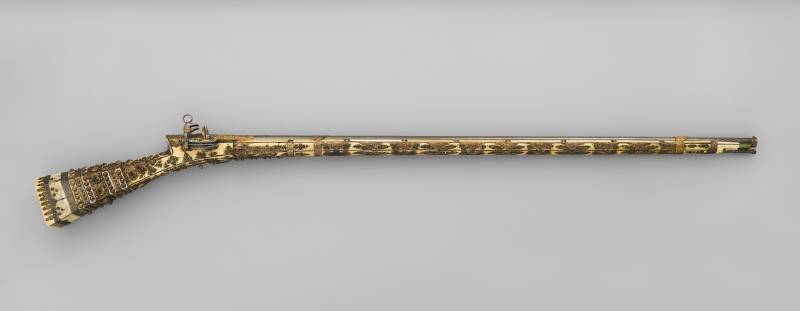
Turkish musket of the late 154,31th century. Materials: steel, wood, ivory, copper alloys, mother of pearl, gold, silver, glass paste. Dimensions: length 119,4 cm; barrel length 12 cm. Caliber 4862 mm. Weight XNUMX g. Metropolitan Museum of Art, New York
The second after the first is also a "man with a gun." It is known about him that this young man was written in St. Petersburg from the son of Varvara Ikskul-Gildenbandt, and he was the great-nephew of the composer Mikhail Glinka and a chamber-page. And it seems that in the picture it is Andrii - the very youngest son of Taras Bulba, whom he gave birth and killed, fulfilling his patriotic duty. True, he has a gun for some reason in a case. An interesting historical fact, but if I were in the place of the maestro, I would have painted him a Turkish musket, only decorated in a different way.
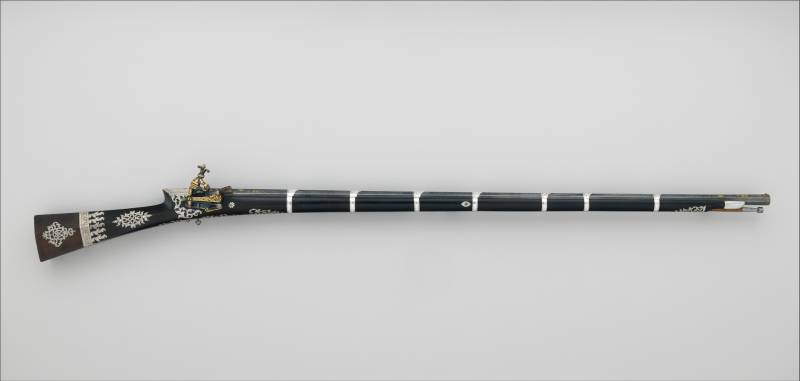
Turkish musket. Date on the trunk: 1151 Hijri (European chronology 1738-1739); castle - 1240 (1824-1825). The trunk is most likely Iranian, the box and lock are Turkish. This is a late example of a traditional Turkish shotgun with a characteristic lock, hexagonal stock, ball-and-socket trigger without trigger guard and a long barrel. The barrel dates back almost a century earlier and is inlaid with gold - inscribed with verses dedicated to marksmanship in the service of Islam. It is believed that this type of shotgun was intended for hunting and target shooting. Materials: steel, wood, silver, gold, copper alloy, ivory, textiles. Length 156,5 cm. Barrel length 120,4 cm. Caliber 15 mm. Weight 5076 Metropolitan Museum of Art, New York
True, he also has a pistol next to the gun. And also Turkish. Well, the Turks made good weapons then. And decorated it richly. Although sometimes quite tasteless. With a sense of proportion, they were clearly ... not very. The one in the photo below is about 70-90 years older, but the Turks' pistols have not changed very much during this time.
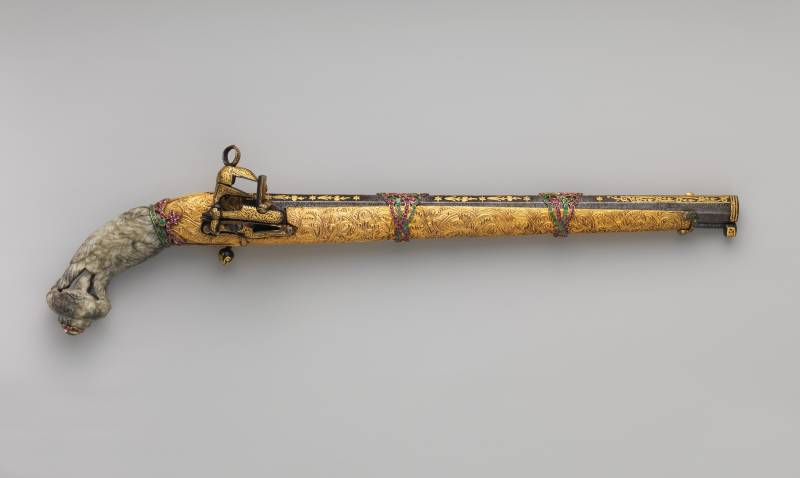
Turkish pistol, approx. 1750-1775; castle dated 1145 Hijri (1732). This extravagantly decorated pistol has a barrel welded from Damascus steel, dated 1732, with 52th century mountings. Presumably created for ceremonial purposes. Materials: steel, jade, gold, emeralds, garnets, gold. Length 36,9 cm; barrel length 15 cm; caliber 1077,2 mm. Weight XNUMX g. Metropolitan Museum of Art, New York
Further out of the armed only a laughing fat man in red. There is an opinion that he wrote it from the professor of the Petersburg Conservatory Alexander Ivanovich Rubets, a descendant of the Polish gentry. But there is also such a version that the journalist Gilyarovsky posed for the painter, so who exactly Repin immortalized as a model of this Cossack has not been established. However, it is important for us that a saber hangs on his belt. It is written out very clearly. And it looks like this ...
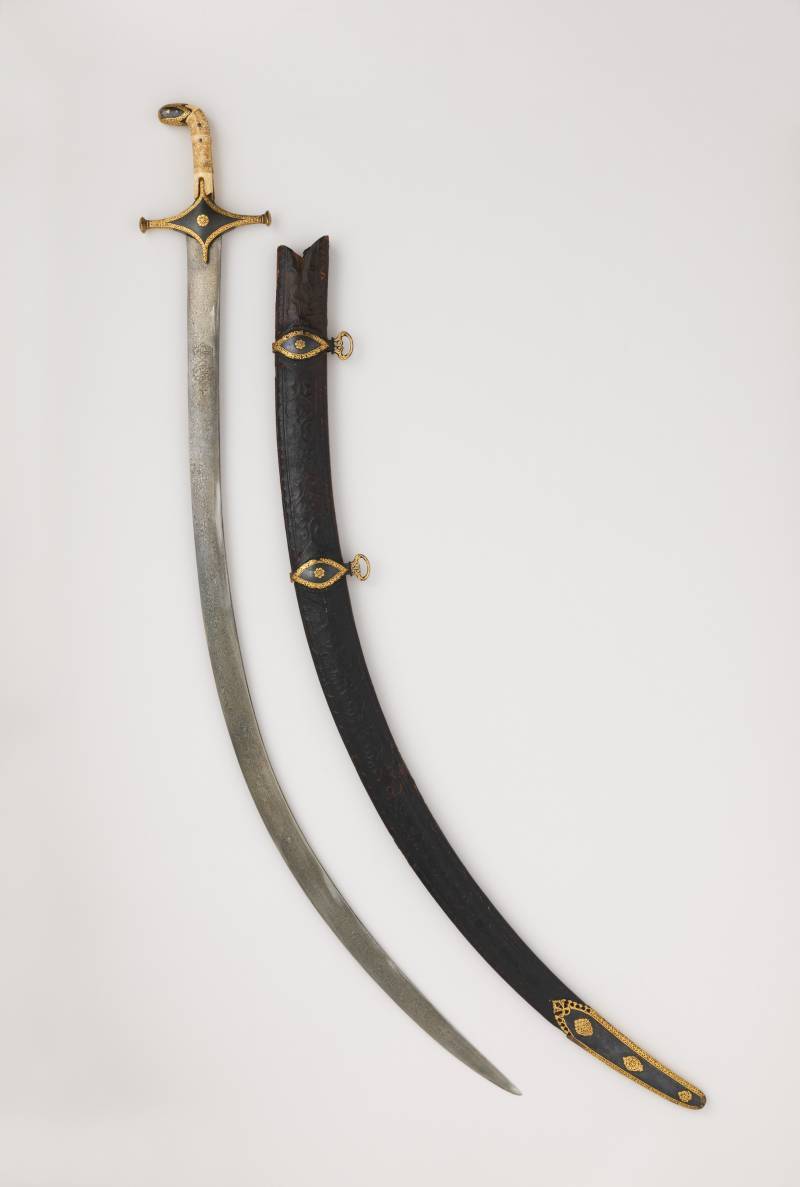
Persian saber shemshir. Dated to 1777-1778. This is a classic example of the Iranian saber (shemshir) of the 1588th century. The blade made of crucible ("cast") steel bears the names of the legendary Iranian swordmaster Asadullah from Isfahan and his patron Shah Abbas I of Persia (reigned 1629-99,7). Since Asadullah's name appears on blades dating from the 83,1th to the 784th centuries, it is likely that most of the signatures are fake. Materials: steel, wood, leather, ivory, gold. Length 420 cm; blade length XNUMX cm. Weight XNUMX g. Scabbard weight XNUMX g. Pay attention to the very powerful and durable crosshair. Metropolitan Museum of Art, New York
And it is not surprising that the saber is Persian. First, the Cossacks went to Persia "for zipuns" too. And secondly, the arms trade in the East has always existed. And the Turkish trophy could well turn out to be a Persian or Indian work.
But what is very interesting to me personally - were there among the Cossack trophies ... straight Turkish broadswords? It is generally accepted in our country that since a Turk means a crooked saber. But in fact, it was the Turkish sabers that had a relatively small bend (the saber fell), and that the Turkish cavalry also used broadswords with blades of European production. Well, for example, such as this one. In time, everything just fits, but whether they were or not - history does not tell us this.
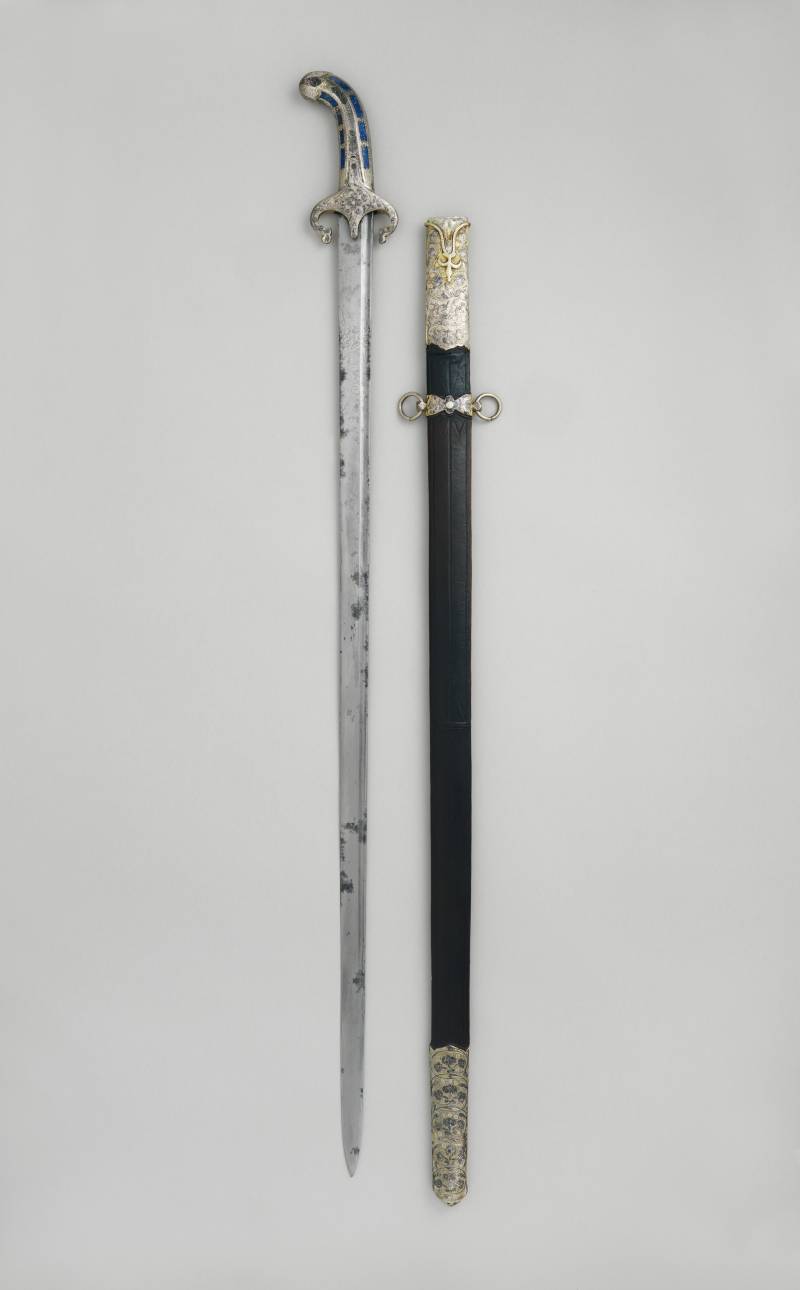
Turkish broadsword. Hilt and guard, late 102,5th century; European blade of the 101th century. Blackened silver diamonds are typical of Ottoman weapons, although lapis lazuli is rarely used. The straight European blade suggests that this cavalry weapon was worn in addition to the more common oriental saber. Interestingly, horsemen in 88,3th century Eastern Europe often had both a saber and a broadsword at the same time. Materials: steel, silver, gold, copper-silver alloy (niello), lapis lazuli, wood, leather. Dimensions: length with scabbard 827 cm; length without scabbard 453 cm; blade length XNUMX cm.Weight XNUMX g. Scabbard weight XNUMX g. Metropolitan Museum, New York
By the way, the fact that the Turks used Indian sabers is undoubtedly. But their handles, originally Indian, were usually replaced by their own, Turkish. They were painfully unusual. And so - a wonderful quality blade and a traditional handle, what could be better?
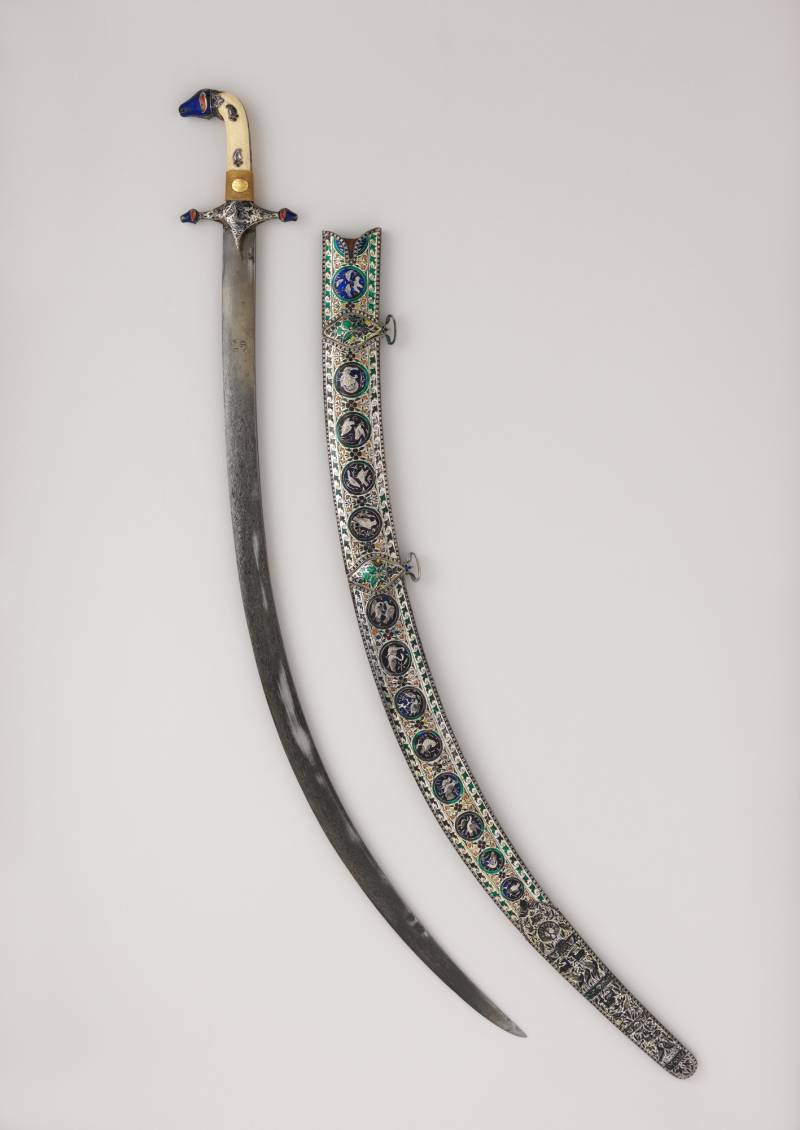
Indian saber. Sling and scabbard 1819 Blade - XVIII century The blade was most likely made in Lucknow, Uttar Pradesh. On the handle there is a gold plate indicating that this saber was presented in 1819 to the captain of the Bengal Army Hugh Caldwell by his commander. The saber is decorated with engraving and silver, typical of Lucknow, where a distinctive school of enameled metalwork flourished from the late 98,4th century. The colorful zoomorphic décor includes ram heads and pommels. Materials: steel, silver, enamel, ivory, gold, glass. Length with scabbard 92,2 cm; length without scabbard 79,1 cm; blade length 1521 cm Weight 1435 Scabbard weight XNUMX Metropolitan Museum of Art, New York
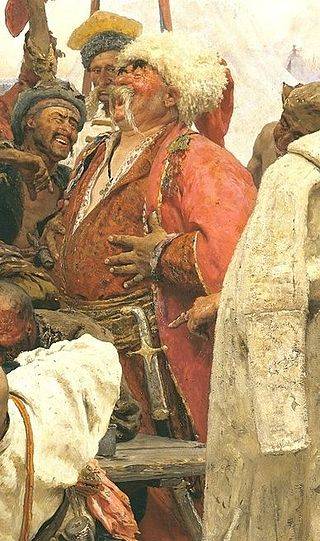
A similar saber for a Cossack in red ...
Another saber of a bald Cossack, collapsed on a barrel. This characteristic dome was written from the chief-gofmeister Georgy Petrovich Alekseev, and he did not expect this trick and was very offended by Repin. However, the artist painted him a noble arsenal: a gun, a saber, and a horn with gunpowder - an important accessory of military equipment of those years.
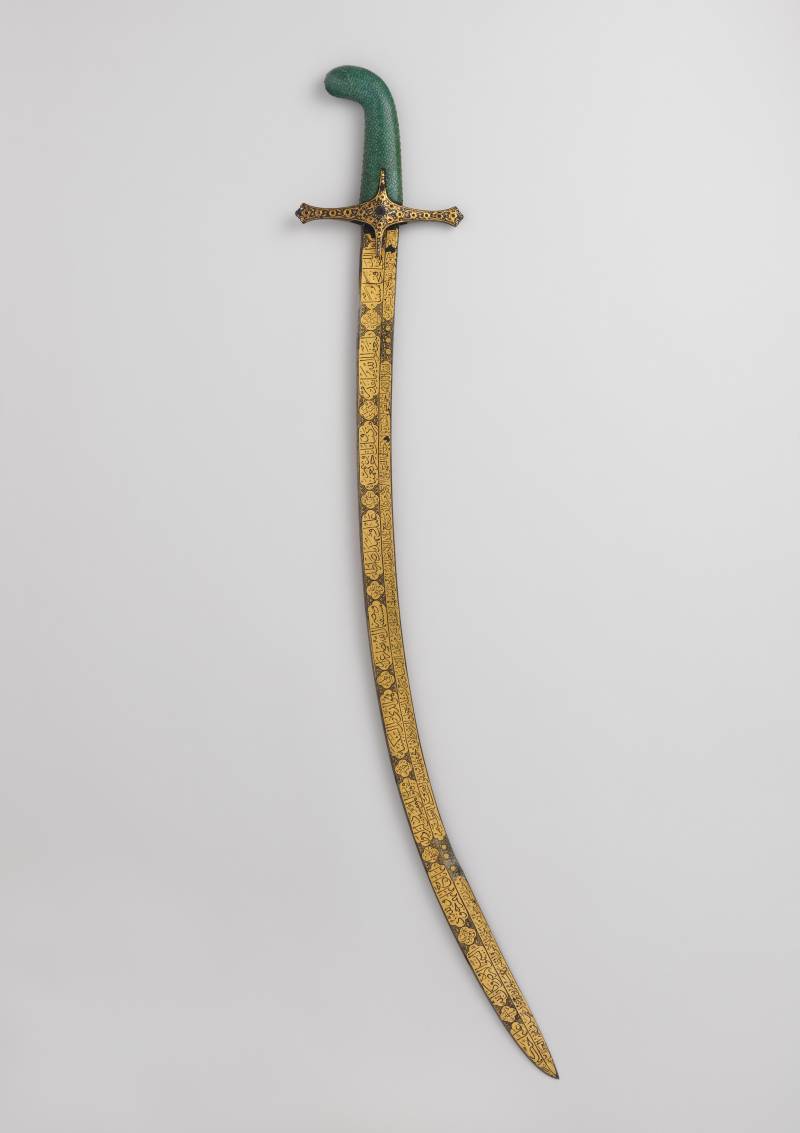
Saber 1522-1566 As you can see, the difference of 100 years, in one direction or in the other, is not so noticeable on Turkish weapons that much. And this saber, among other things, also has one of the best and best-preserved Islamic blades of the 96,2th century. Its gold-encrusted decor consists of Quranic inscriptions that emphasize the sovereignty of God, the wisdom and strength of his servant Solomon. These seem to be clever allusions to the Ottoman Sultan Suleiman the Magnificent. The absolutely luxurious crosshair of the saber is embossed with gold, and earlier it was also inlaid with precious stones. Although the handle is a later replacement. Materials: steel, gold, fish skin, wood. Dimensions: length 78,1 cm; blade length 1049 cm.Weight XNUMX Metropolitan Museum of Art, New York
However, a horn with gunpowder is, although typical, but not the most beautiful option. The fact is that not only horns were used as powder flasks, but also specially made powder flasks. And it was precisely such a powder flask that Repin masterfully painted on the belt of a Cossack naked to the waist. It was believed that in such a "naked form" the Cossacks sat down to play cards and would not be able to cheat and hide cards up their sleeves. He has a very beautiful powder flask - again, clearly oriental work. By the way, there is something similar in the exposition of the Metropolitan Museum. Moreover, Indian work ...
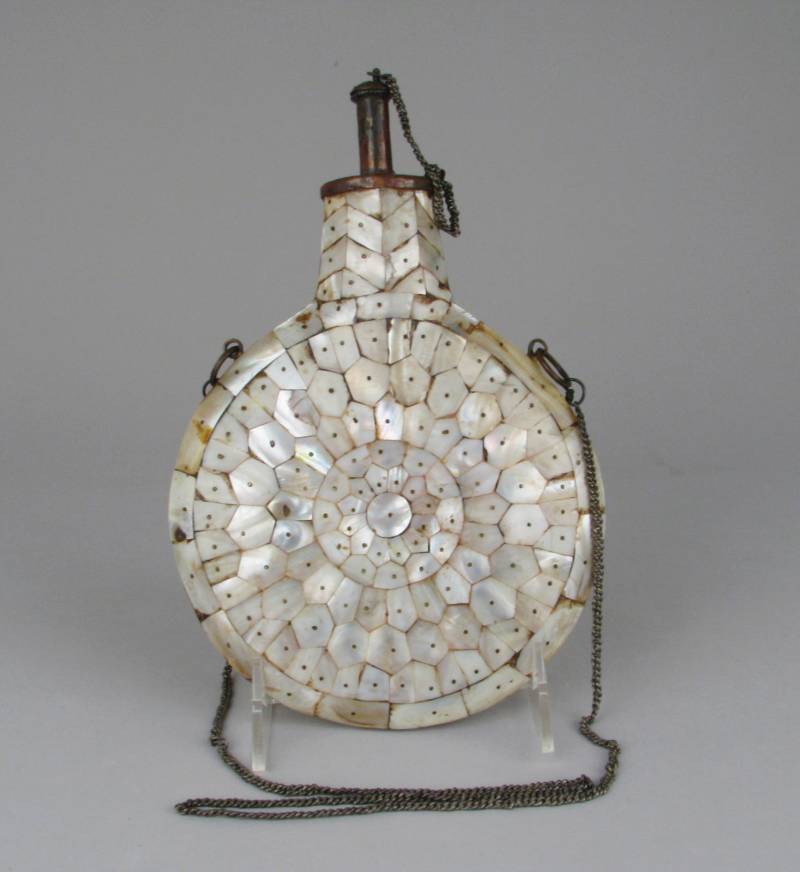
Powder flask from India, 22,9th-15,2th centuries State of Gujarat, manufactured for export. Mother of pearl inlay. Dimensions: 3,5 x XNUMX x XNUMX cm Metropolitan Museum of Art, New York
And finally, this one. Again, the Cossack's weapon on the barrel is such a small detail next to the gunpowder horn. But this is nothing more than the head of a brush - a weapon of the common people, but effective in skillful hands.
However, there is another example of Turkish weapons, which is not in the picture. This is a scimitar. But ... although they fell into the hands of the Cossacks, however, most likely they were not used. Since the majority of Turkish scimitars had a whimsical handle. And one had to be able to use such a weapon. So it is understandable why there is no scimitar "with ears" on the handle on the canvas. But it could well have been a scimitar with a handle of a more familiar look, and why not take such a trophy? But ... this weapon was not typical. Although there are remarkable examples of scimitars with handles of a completely European look. For example, this one ...
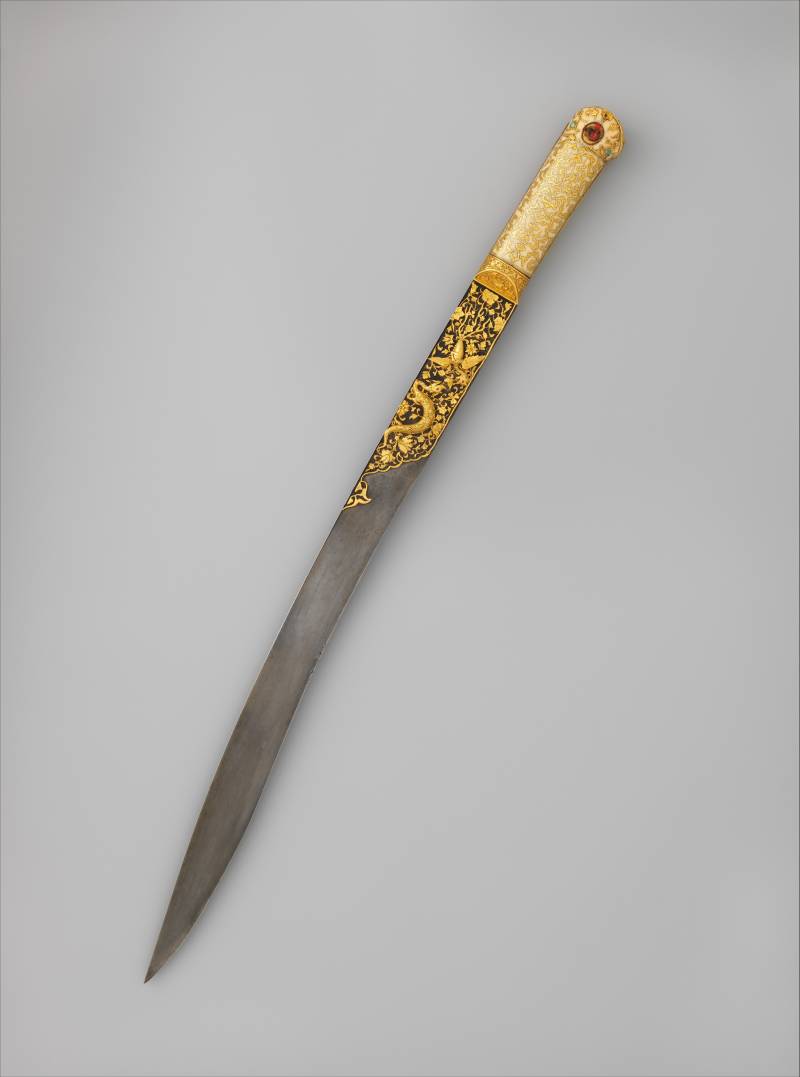
The scimitar of the era of Suleiman the Magnificent (reigned 1520-1566). Workshop of Ahmed Tekel, possibly an Iranian, c. 1525-1530 Exquisite craftsmanship and the use of precious materials epitomize the richness and sophistication of Ottoman weaponry. There is an almost identical scimitar in the Topkapi Palace in Istanbul, and it is obvious that they were both made in the same workshop. The gold inlay on the blade depicts the battle of the dragon and the phoenix bird. The clouds inlaid with gold on ivory handles, apparently, were spied on from the Chinese and, probably, got into Ottoman art through contacts with Persia. This scimitar is one of the earliest known scimitars, and it is clearly a Turkish weapon, characterized by a double curved blade and ... a very simple handle without a guard. Scimitars were common weapons in Turkey and the Balkans during the 59,3th and 46,7th centuries, and were worn by elite troops such as the Janissaries. Materials: steel, gold, ivory or walrus bone, silver, turquoise, pearls, rubies. Dimensions: length 691 cm; blade length XNUMX cm; weight XNUMX g. Metropolitan Museum of Art, New York
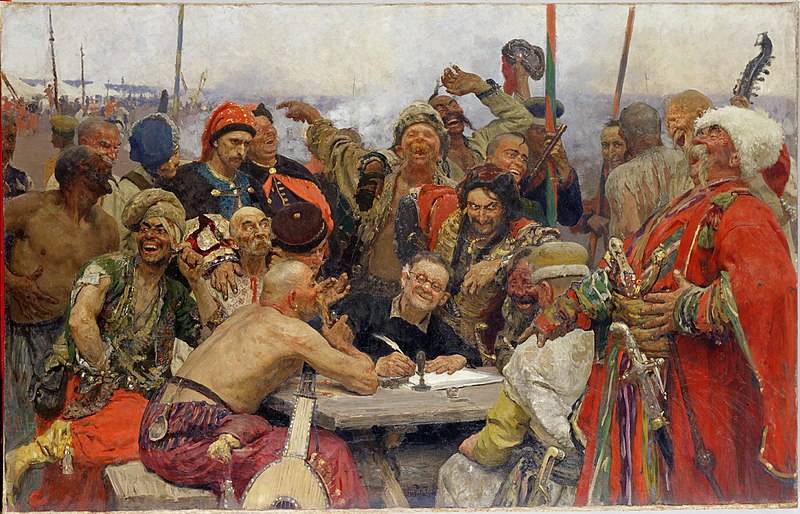
The second version of the painting of 1893, kept in the Kharkov Art Museum
Well, we have considered all the weapons of the Repinovsky Cossacks, and what is the conclusion? Simple - that it is precisely the weapon in the paintings that needs to be drawn, and where do you get the initial samples for this - in the Kremlin Armory or in the Metropolitan Museum of New York - it does not matter at all.
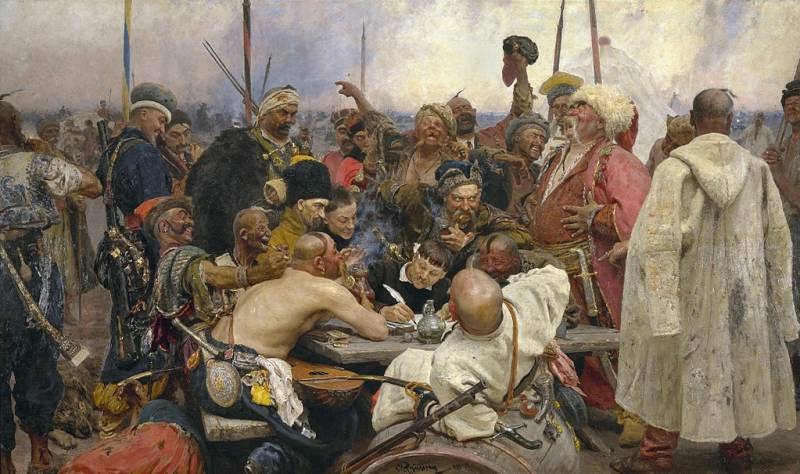
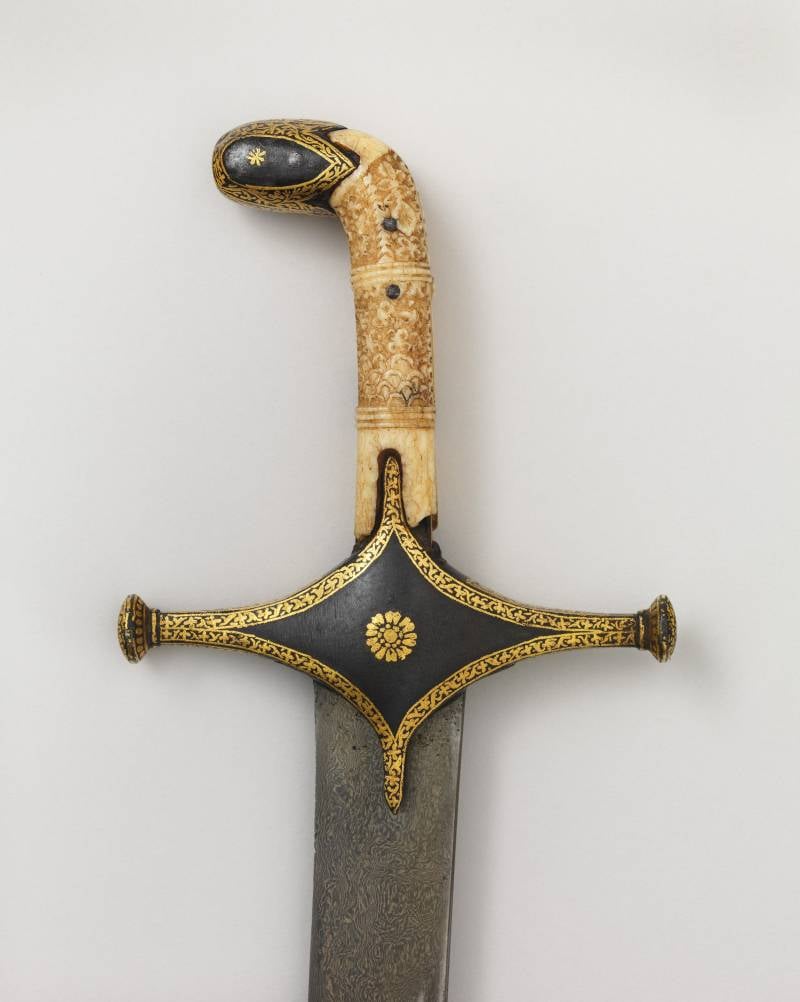
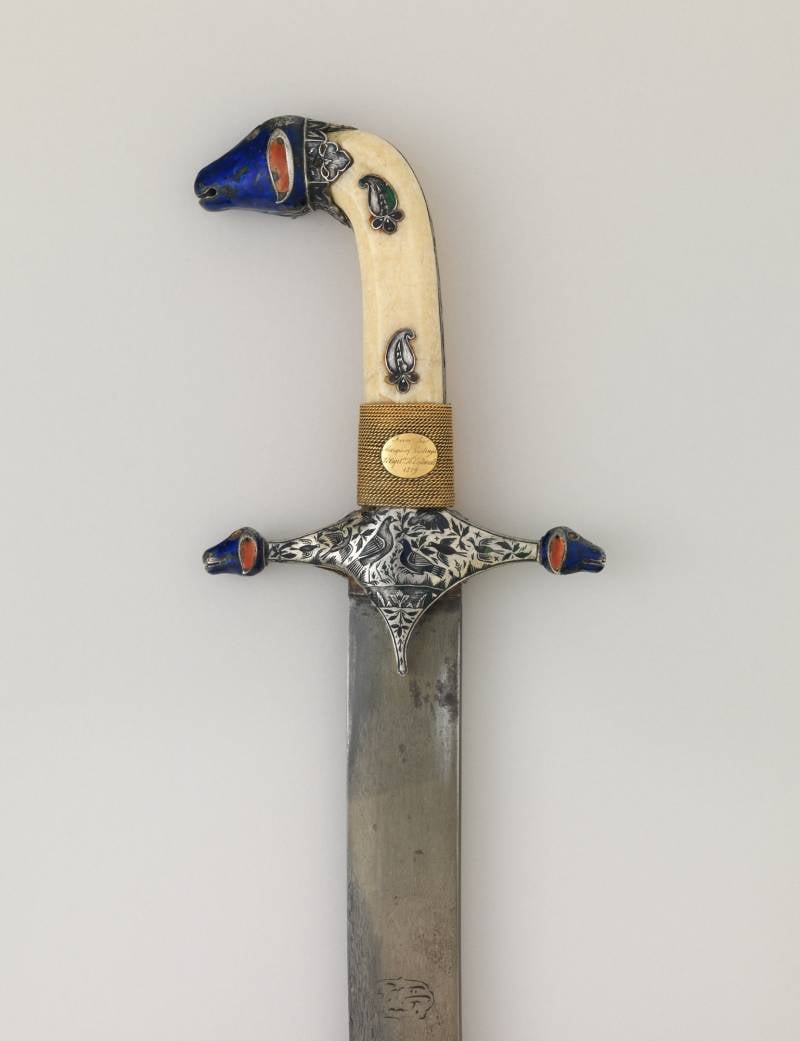
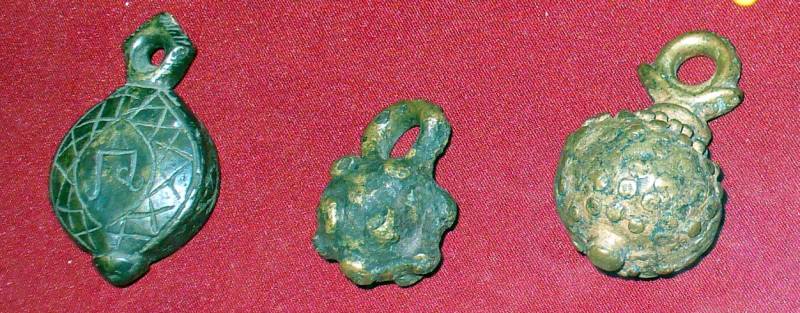
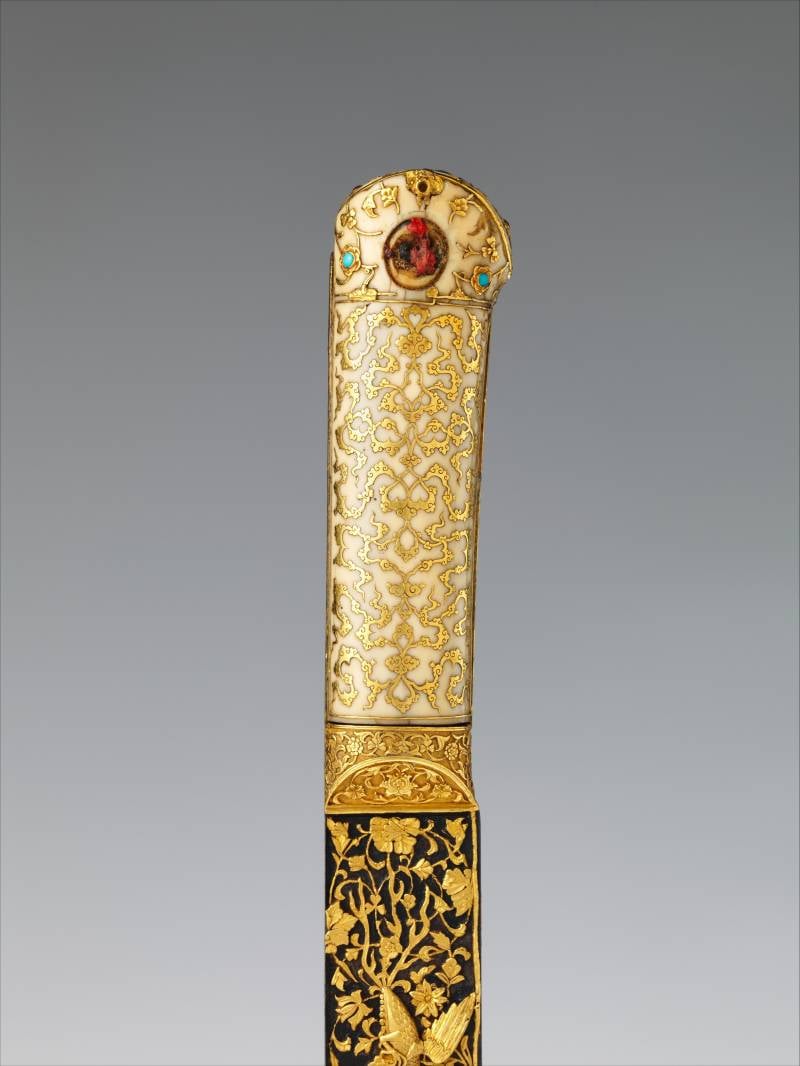
Information